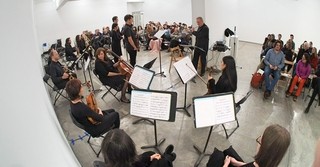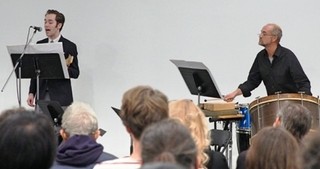|
Back
Creations Alluring And Alienating New York
Paula Cooper Gallery, 521 West 21st Street
12/19/2015 -
Iannis Xenakis: Kassandra
Eli Greenhoe: Etymology
Pavel Jan Vejvanovský: Sonata la posta; Serenata in C (U.S. Premiere)
Alvin Lucier: Orpheus Variations (U.S. Premiere)
Liisa Hirsch: Four Glides (U.S. Premiere)
Petr Kotik: Reiterations and Variables
Kamala Sankaram (Soprano), Jeffrey Gavett (Baritone)
William Lang (Trombone), Chris Nappi (Percussion), Charles Curtis (Violoncello), Conrad Harris, Pauline Kim Harris (Violins), The Orchestra of the S.E.M. Ensemble, Petr Kotik (Flutist/Conductor/Artistic Director)

S.E.M Ensemble, flautist P. Kotik (© Michael Yu)
Any concert by the extraordinary virtuosi of the S.E.M. Ensemble is a celebration, though I did almost walk out of their performance of John Cage’s Atlas Eclipticalis several years ago. That was, I am assured by those wiser than myself, my own shortcoming. Artistic Director Petr Kotik may have contentious repertorial choices, but he is a serious and inventive conductor.
As well as most inventive composer. In this long but never long-winded 31st annual holiday concert, I felt a shuddering fear that Mr. Kotik’s Reiterations and Variables, the final work of the evening, would be a lengthy homage to his friend and mentor John Cage. Instead, the four blocks of music–works he had composed over the past three months–were fascinating inspirations which ranged over several centuries.
The first part, a fairly rapid chanting of Gertrude Stein words by soprano Kamala Sankaram and baritone Jeffrey Gavett, with the slow cumulative additions of trombones and trumpets, resembled late Byzantine coronation music. The poetry was of an unvarying meter, the brass resonating as if in Constantinople’s Hagia Sophia cathedral. With the second “movement”, we had an equally strange duet of violinists Conrad Harris and Pauline Kim Harris, followed by a frenzy of all the soloists (frenzied but never anarchic) by the entire ensemble and Mr. Harris’s last so beautiful solo.
That work stood out because at least one listener (myself) experienced a feeling of ancient Greek Orthodox litany at the start. I doubt if this was Mr. Kotik’s intention (he said the composing was “intuition, without any clear idea of what to do with them later”), yet it did have an other-millennium effect.
Yet two of the other works literally did have Greek origins. One of them was stunning the other, well….we’ll come to that later.
Anyhow, Iannis Xenakis’ Kassandra, an addition to his wondrous long choral/vocal Oresïa, performed at Columbia University some years ago, was the closest I have ever heard with music that very well could have been in an original Greek drama. We had the right instruments. The pslaterion (a miniature psaltery) , its high gentle tinkling like faraway sleigh bells was played by the vocal soloist. (The psaltery belonged to the Hebrews, while the Greeks had the lyre, but hey, this was a 1987 composition). We had percussion: a bass drama, conga drum, woodblocks, two other drums, played by two sets of mallets. And we had the voice–or voices–of baritone Jeffrey Gavett.

J. Gavett, C. Nappi (© Michael Yu)
In the Xenakis score, the baritone must sing in high falsetto as the oracle Cassandra; and in more normal baritone range as the Chorus of Elders. The language is apparently ancient Greek, though the melissimae made this less than simple two-voiced singing.
What Mr. Gavett accomplished was a seamless vocal duet with himself: that was the technical triumph. Artistically, even without knowing the words or the poetry of the Aeschylus drama, we had here what the Greeks themselves expected: a necromantic incantation.
No, the Greeks were far too practical to think of it was magic. Yet I had only heard this kind of singing twice before. Once in Bali, where the singing was an ancient form of Indonesian not comprehended by any in the still-awestruck audience. And once in southern Korea, a female shaman standing by the ocean in the moonlight, also using high and low registers in her prayers.
The Korean shaman off Cheju Island was accompanied by the waves of the ocean. Mr. Gavett had the drumming of Chris Nappi. Hard punctuations, brittle battle-tattoos, woodblocks in melodic concordance, drumming as counterpoint and song at once. We know little about the actual performance, but one doubts that the original Hellenic audiences would have been alienated by the sounds.
The second Greek work, Orpheus Variations, was based on a single chord from Stravinsky’s Orpheus, the sonority of which had “haunted” composer Alvin Lucier, who was in the audience. The chord was between F and B, with a C added (like a post-nasal drip). And for this, cellist Charles Curtis played “3 iterations of 103 permutations of the tones of the chord.”
Barely heard above the brass and one flute, Mr. Curtis evidently did permute in a piece which seemed longer than Stravinsky’s half-hour ballet, was of an unvarying slow tempo, a uniform mezzopiano volume, with the same intervals repeated again...and again...and again over the fingerings of Mr. Curtis.
Again, I plead my own shortcomings, yet Orpheus Variations seemed not only unvaried, but, in comparison, made the music of Morton Feldman sound like John Philip Sousa.
Another outstanding soloist was William Lang, a well-known trombone soloist here in Eli Greenhoe’s appropriately-named Etymology. Etymology, says the composer, “is the study of its evolution into modern usage.” It’s more than that, but Mr. Lang did indeed “evolve” his instrument. It wasn’t necessarily evolved to modern usage, but it was a study in increasing complexity. Starting on a single muted C Sharp, Mr. Lang, with and without mute, with breaths, double-tones, triple-tonguing and a variety of sound brought that one note organically into a far knottier, labyrinthine, and moving piece, ending with a pure brassy open note which summed up the entire composition.
Estonian composer Liisa Hirsch was on hand to supervise a work of crystalline sensitivity. The basis was a black-and-white projection of a hand s-l-o-w-l-y feeling the wires inside a keyboard. One didn’t hear the vibrations initially, but the overtones, the glissandi, were softly resonating, and from this, the eight string and brass instruments of S.E.M. could create their own sound space, rarely departing from the original notes but varying in microtones and oh so infinitesimal shadings.
The music was new to many in the whitewashed Paula Cooper Gallery, but S.E.M. always provides an even newer experience with an older composer. In this case, the Czech-born Petr Kotik must have hand-picked Pavel Jan Vejvanovský, the 17th Century Moravian trumpet-player/composer/conductor of (I love to say this) Prince-Bishop Karl Lichtenstein-Kastelikorhn’s Kromeŕíž Palace. And indeed., the first work was like a concerto grosso for brass and strings. For the Serenata, the composer was in the tradition of Telemann, Janácek, and Szymanowski in using the folk-tunes of the area.
I mentioned before the “extraordinary virtuosi” of the S.E.M. ensemble, and am happy to repeat it. The music of the two-and-a-half hour concert, alluring, adversative, archaic–or alienating–was given care owed to the most rarefied creations.
Harry Rolnick
|